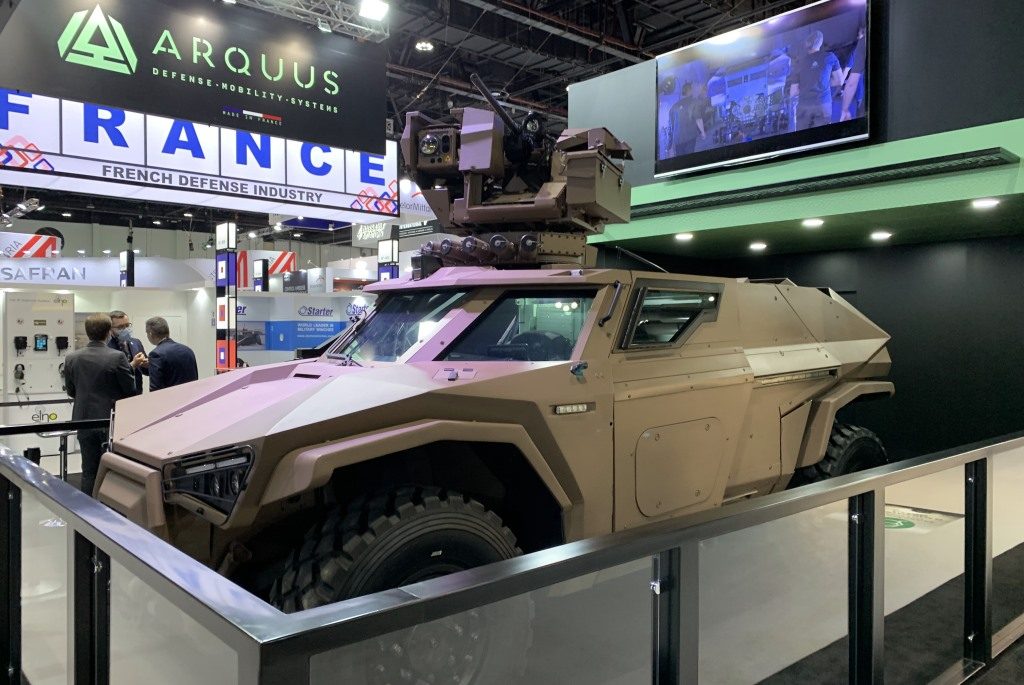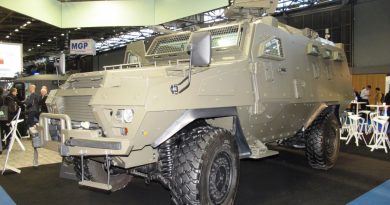
First public appearance for Arquus Scarabee hybrid recce vehicle
IDEX 2021 marks the first public appearance of Arquus’ Scarabee, the 4×4 light armoured vehicle having been discretely unveiled during Eurosatory 2018, when it was shown only to selected visitors, and then at company events, such as Arquss Technodays 2019 and Arquus Day 2020. The company aimed at exhibiting it at Eurosatory, but the cancellation of that event due to the pandemic made IDEX the ideal international platform where to show its new hybrid vehicle, now that it has become a product and it is marketed worldwide, the Middle East being of course one of the areas of interest.
Much of the vehicle is already known to our readers. At 8 tonnes GVW, it features a hybrid powerplant, based on a V6 VMM diesel engine providing 300 hp coupled to a 400 V 70 kW electric machine (100 hp equivalent) and to an automatic 8-speed transmission. Propulsion can be diesel only, in which case the internal combustion engine will reload the Li-Ion battery pack, diesel plus electric, adding the power and the immediate torque of the electric machine to that of the diesel to provide high acceleration in case of need, and electric only, the stealthy mode optimal for a recce vehicle like the Scarabee. The huge electric power available on board also allows for a silent watch on batteries only for an extended period, ensuring minimal acoustic and thermal signature. The Scarabee is 5.25 meters long, 2.1 meters wide and 2 meters high, a compact vehicle with low visual signature, and carries a crew of three plus eventually one more passenger. Protected against mines, it has a ground clearance of 0.385 meters notwithstanding its low profile, IEDs, and kinetic energy threats, levels remaining classified. The vehicle is equipped with fully independent suspension with variable height, and with 365/80 R20 tires. Capable to ford a 0.8 meters deep-water obstacle, a critical issue for hybrid vehicles, to overcome a 0.4 meters high obstacle and a 0.9 meters wide trench, the Scarabee can climb a 60% gradient and its low centre of gravity permits it to cope with a 40% side slope.

After summing up the vehicle characteristics, let’s understand the latest evolution of this innovative vehicle in the words of Nicolas Dekyvere, Arquus tactical vehicles Product Manager. “In these 3-4 years since we first introduced the Scarabee we developed it, transforming it from a moving prototype to a vehicle capable to withstand validation trials,” he tells EDR On-Line. The company went through a complete recalculation process together with numerous field trials, including and ergonomy tests with potential customers. “The vehicle can run in three different modes, the normal one, in which the electric machine adds its power and torque to that of the diesel when required,” Dekyvere explaining that there are a number of settings depending on operational priorities, on which he did not elaborated further. “Mode two is the one in which priority is given to maintain the charge of the 10 kWh Lithium-Ion battery package, in this mode the 70 kW machine allowing for a quick recharge. Finally the all-electric mode, the system allowing for a 10 km range off-road at 15 km/h in the battery-only mode,” Dekyvere says. Somebody may consider 10 km a short stretch, however the company tactical vehicles product manager explains that this comes from customers experience: “talking to operational units, they said that the average final silent approach distance required would be of 3-4 km forth and back, therefore we considered that 10 km would provide the crew a good feeling in terms of spare distance to run in silent mode.” This also allows to cope with battery performances degradation in extreme hot and cold conditions, the available electric power also allowing for 8-10 hours silent watch, the quick charging eventually allowing to remain in position for much longer periods while switching on the engine for very limited periods of time. Speed is a factor when looking for minimal acoustic signature, the electric drive allowing to obtain much reduced low speeds compared to conventional propulsion, a further advantage in the last kilometres approach. The creeping speed would also allow to have a vehicle, armed i.e. with a 30×113 mm cannon, advancing at the pace of dismounted infantry, providing a considerable fire support,” Dekyvere tells EDR On-Line, highlighting how the peculiar performances of the Scarabee possibly bringing to new missions.

The development phase allowed Arquus improve the vehicle reliability in many areas, among which the McPherson suspension, the rear independent steering axle, which can be counter-steered to reduce the turning radius or steered the same way of the front axle for crab movement. Some feedback from potential customers will bring major differences in the vehicle look. “One of the main changing will be in the doors, the prototype featuring sliding doors while pre-production vehicles will have more classic hinged doors,” Dekyvere says, explaining that customers were not confident in that solution, the new doors also allowing a considerable weight saving, weight being a key factor, which explains the aluminium-composite proprietary solution adopted for the hull providing required protection levels against both ballistic and blast threats, as well as a optimal protection-to-weight ratio.
While the customers thrust led to change the doors geometry, the central driving post, with a wide field of view, was much appreciated as well as the flat floor, without the protruding tunnel typical of 4×4 vehicles. The same applied to the closeness between the three occupants, although the vehicle is fitted with a state of the art intercom, communications within the crew being key in reconnaissance missions. “The Scarabee is fitted with our Battlenet battle management system in the Elite configuration, that is with all the options,” Dekyvere says. The Battlenet is available in three configurations, Select, Prime and Elite, the latter including a rear camera, commander and driver’s screens, the link to the RCWS, four short range cameras covering 360°, Blue Force Tracking, health usage and monitoring systems, the system being compatible with self-protection sensors which for the French Army would be those selected for Scorpion vehicles, the open architecture allowing easy integration of other similar systems for export customers.

At IDEX Arquus will propose to potential customers its hybrid Scarabee in three different versions, the actual vehicle exhibited being the only prototype build until now fitted with a Hornet RCWS. “For the reconnaissance version, which is the original mission of the Scarabee, we propose the vehicle fitted for a RCWS armed with a 30×113 mm cannon, the crew being of three plus one elements, thus four intercoms and fitted for two radio sets,” Nicolas Dekyvere tells us. The Special Forces version named PATSAS (PATrouille SAS)is also fitted with four seats, and on the roof features a Hornet RCWS tailored for export, with its main optional, the independent smoke grenade launcher ring and ballistic protections, the weapon proposed being the M2 12.7 mm machine gun. The third proposal is for a security/antiterrorism vehicle, with a tree-man crew, the RCWS proposed being the company Hornet, armed with a 12.7 mm MG, but in its short version, without smoke grenade launchers; here the vehicle compactness is the key element as it allows the Scarabee to swiftly move in urban canyons, to which it adds its peculiar manoeuvrability given by its steering axles allowing it also to move sideways as a crab. These are the current proposals made by Arquus, “however we are well known for our capacity to adapt our platforms to customers’ needs, therefore these are far from being the only variants that can be envisaged for the Scarabee,” Dekyvere points out. The huge on-board power availability open doors to many solutions, among which a laser-based weapon, to be used i.e. in the C-UAS role.

EDR On-Line understood that a second prototype, closer to the production vehicle, is needed, both for development as well as for demonstration purposes, Arquus not elaborating further on that subject. What is clear is that since Autumn 2020, when foreign delegations could witness the vehicle performances during the Arquus Days, the new hybrid reconnaissance vehicle has become a fully-fledged product, the commercial campaign having started at full steam.
Photos courtesy Arquus



